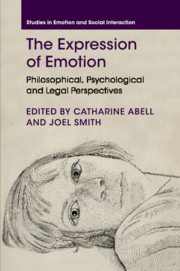Book contents
- Frontmatter
- Contents
- Notes on Contributors
- Acknowledgements
- Introduction: Emotional Expression
- Part I Philosophical Perspectives
- 1 Expressing, Showing and Representing
- 2 Emotions and Their Expressions
- 3 Expressive Actions
- 4 Emotional Expression, Commitment and Joint Value
- 5 Collective Emotion and the Function of Expressive Behaviour
- Part II Psychological Perspectives
- Part III Legal Perspectives
- Index
- Miscellaneous Endmatter
- References
2 - Emotions and Their Expressions
from Part I - Philosophical Perspectives
Published online by Cambridge University Press: 05 September 2016
- Frontmatter
- Contents
- Notes on Contributors
- Acknowledgements
- Introduction: Emotional Expression
- Part I Philosophical Perspectives
- 1 Expressing, Showing and Representing
- 2 Emotions and Their Expressions
- 3 Expressive Actions
- 4 Emotional Expression, Commitment and Joint Value
- 5 Collective Emotion and the Function of Expressive Behaviour
- Part II Psychological Perspectives
- Part III Legal Perspectives
- Index
- Miscellaneous Endmatter
- References
Summary
Introduction
Expressions such as ‘I see the anger in his face’, ‘I can hear the disappointment in her voice’ and ‘[s]he felt him trembling with fear’ imply that the emotions of others are things that we can sometimes perceive – that is, things that we can see, hear and feel. However, one might think that, strictly speaking, the perceptual language here is misleading. One might, that is, think that when we say things like this, we do not really mean that the other's state of mind is perceptible in the same way that ordinary objects in our visual field are perceptible. Rather, to say, ‘I see the anger in his face’, is to offer a kind of shorthand for something like this: I see him make a facial expression that people commonly make when angry, and so infer that he is angry. So, ordinary locutions such as ‘I see the anger in his face’ are misguided. They imply that emotions, like ordinary objects, are perceptible, and that behaviours that express our emotions enable non-inferential knowledge of them by others. But in fact there is no literal perception of emotions; at most what is perceived are behaviours that express the emotions, and our knowledge of others’ emotions is always mediated by our knowledge of other things, so that, even in paradigmatic cases where we take ourselves to recognize someone's emotion in their behaviour directly, what we do is infer the presence and character of the emotion on the basis of behavioural evidence.
Note, however, that if our ordinary language is misleading in this way, then it is also misleading with respect to the relationship between emotions and their expressions. We often describe faces as happy or relieved, voices as anxious, joyful or scared, bodily demeanours as embarrassed or confident and so on. (Indeed, as one author has observed, there really appear to be no independently characterizable kinds under which, for example, the facial expressions associated with sadness, or joy, fall, but that ‘can be described without reference to the emotions’ – Peacocke [2004]: 66.) Our descriptions of expressive behaviours suggest that we take the emotions to be embodied in the behaviours that express them – the relief is somehow right there in his face, the joy is somehow right there in her voice and so on.
- Type
- Chapter
- Information
- The Expression of EmotionPhilosophical, Psychological and Legal Perspectives, pp. 46 - 72Publisher: Cambridge University PressPrint publication year: 2016
References
- 2
- Cited by



